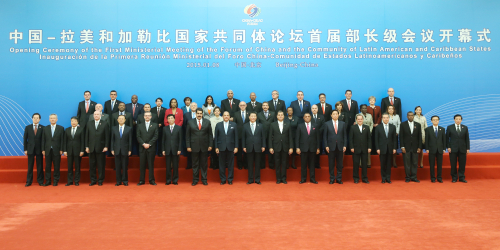|
 |
|
CROSS-REGION COOPERATION: Chinese President Xi Jinping (center, front) and participants of the First Ministerial Meeting of the Forum of China and the Community of Latin American and Caribbean States pose for a group photo in Beijing on January 8 (YAO DAWEI) |
The two-day First Ministerial Meeting of the Forum of China and the Community of Latin American and Caribbean States (CELAC) concluded in Beijing on January 9, with both sides vowing to deepen political mutual trust, expand cooperation and promote the forum's development. The platform is thus becoming a new part of China's "1+N" multilateral diplomatic network, which also includes China-Southeast Asia, China-Africa and China-Arab cooperation mechanisms as well as the Shanghai Cooperation Organization consisting of China, its Central Asian neighbors and Russia.
Established in December 2011 in Caracas, Venezuela, CELAC is a bloc of 33 members, including all South American countries, some Caribbean states and Mexico. The ministerial meeting in Beijing welcomed representatives of 30 CELAC countries. Chinese President Xi Jinping, Costa Rican President Luis Guillermo Solis, Ecuadoran President Rafael Correa Delgado, Venezuelan President Nicolas Maduro Moros as well as Bahamas Prime Minister Perry Christie attended the opening ceremony of the meeting.
Observers said that the Beijing meeting marked a significant step forward for overall relations between China and CELAC.
Benefits for all
Compared with China's cooperation platforms with other regions, the year-old China-CELAC Forum is a late arrival. In July 2014, Chinese President Xi and CELAC leaders announced the establishment of the China-CELAC Forum at the First China-Latin America and the Caribbean Summit in Brasilia, Brazil. They also agreed to hold the forum's first ministerial meeting as soon as it could be arranged.
Latin America is now one of the world's most vibrant regions in terms of economic development, and its role on the world political stage has also become much more prominent. China and countries in the region share similar aspirations to raise the global profile of emerging economies and that of developing countries, laying the foundations for their dynamic partnership.
Over the past decade, trade between China and Latin America has maintained a formidable annual growth rate of 30 percent and trade volume between the two sides increased 20-fold to $261.6 billion from 2002 to 2013, making China the second largest trading partner of the region as a whole. Meanwhile, Latin America has already become China's second largest investment destination after Asia with China's direct investment to the region totaling $861 billion in 2013. Additionally, Latin America is the third largest source of foreign investment for China. Since Xi took office as Chinese president in March 2013, he has visited Latin America twice, showing the importance China attaches to the region.
However, dialogues and cooperation between the two sides have been mostly conducted via bilateral channels. This method of interaction could prove less efficient at a time when cross-region cooperation calls for a more comprehensive mechanism.
Cui Shoujun, an associate professor on Latin American studies at the Beijing-based Renmin University of China, noted that besides the remote geographical distance, the lack of an integrated regional platform in the past was to blame for the lagging behind of overall China-Latin America relations. In addition, Cui said there are still 12 countries in the region that have not established official relations with China.
Nevertheless, the rapid development of globalization and regional integration has gradually overcome the hurdles between the two. The establishment of CELAC, in particular, has created an opportunity for the overall cooperation between China and Latin America as a whole.
Currently, most Latin American countries are urgently pursuing development. Wu Hongying, Director of the Latin American Institute under the China Institutes of Contemporary International Relations (CICIR), said that China's rich experience in such development has helped pave the way for cooperation between China and Latin American nations.
Wu added that the cooperation between the two sides is an important supplement to the bilateral collaboration between China and regional countries, for which the Beijing ministerial meeting has mapped out the approaches and directions.
| 